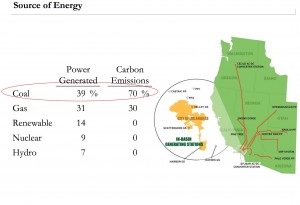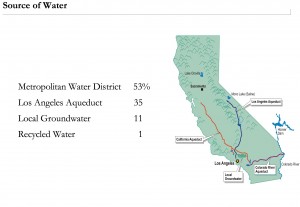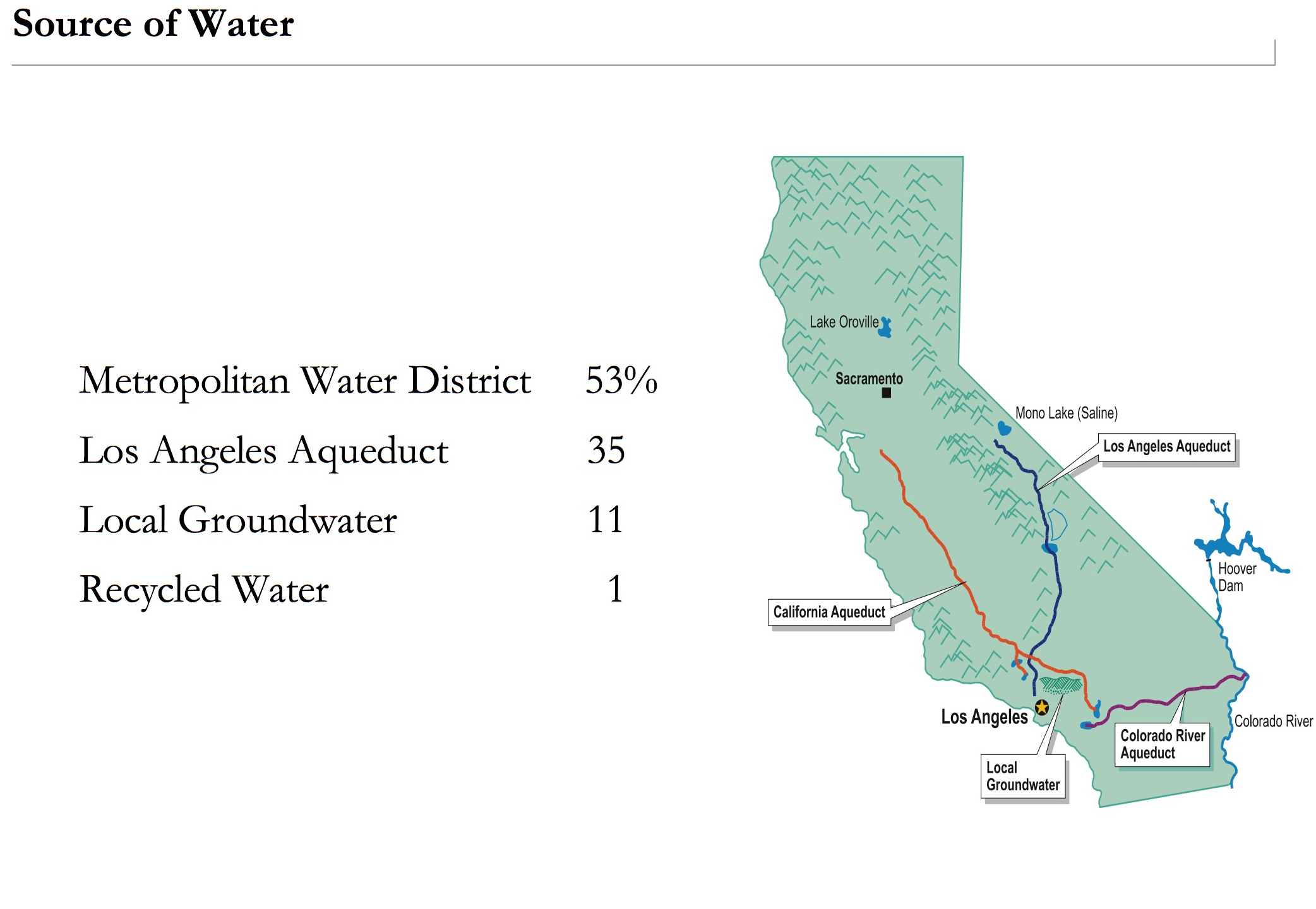By popular demand
Posted on | June 2, 2010 | 1 Comment

Marianne Simon of the Santa Monica firm Poetic Plantings was noted for her design's permeable paving, screening, recycled materials and use of Mediterranean, California native and edible plants.
After more than 4,000 votes were cast by the public, the City of Santa Monica has announced the winning designs for its three sustainable demonstration gardens to be installed this fall off Airport Boulevard. Click here to read about the winners in the Los Angeles Times.
Tags: chance of rain > City of Santa Monica > demonstration gardens > Emily Green
Water and power(point)
Posted on | June 2, 2010 | 1 Comment

 The Los Angeles Department of Water & Power yesterday released a sketch operating budget for 2010/11, which the Los Angeles Times reports may spell rate hikes from 4% to 8% for consumers. For those interested in the source of their water and power, the budget offers some nice graphics (lifted left; click to enlarge). As a couple of asides, the cost of converting from coal to renewable sources of energy inspired the recent rebellion in the Los Angeles City Council; and consistent clean hydropower from Hoover Dam is dependent on adequate elevations in Lake Mead, a source threatened by inadequate conservation programs by the department and its umbrella agency, the Metropolitan Water District of Southern California.
The Los Angeles Department of Water & Power yesterday released a sketch operating budget for 2010/11, which the Los Angeles Times reports may spell rate hikes from 4% to 8% for consumers. For those interested in the source of their water and power, the budget offers some nice graphics (lifted left; click to enlarge). As a couple of asides, the cost of converting from coal to renewable sources of energy inspired the recent rebellion in the Los Angeles City Council; and consistent clean hydropower from Hoover Dam is dependent on adequate elevations in Lake Mead, a source threatened by inadequate conservation programs by the department and its umbrella agency, the Metropolitan Water District of Southern California.
Click here to be taken to the proposed LADWP budget, or here for yesterday’s report card for the department, which in the face of incompetent leadership by the Mayor of Los Angeles and turbulent city council politics has gone through nine general managers in 10 years while elevations keep falling in Lake Mead, the country’s largest storage reservoir and key water and power source for the West.
High good, low bad: Mead in May 2010
Posted on | June 1, 2010 | 1 Comment

Two graphics from the 2007/2008 Annual Report of the Metropolitan Water District of Southern California (the most recent available) illustrate how water exports from the San Joaquin and Sacramento River Bay Delta (right) rose sharply as surpluses dried up on the Colorado River (left) after 2002. Click on the image to enlarge the graphics.
Eleven years into a dramatic drought* on the Colorado River, in 2009, the City of Los Angeles finally saw fit to issue a lawn watering ordinance that reduced sprinkler irrigation to a twice weekly schedule. It was an overdue and obvious step given that roughly half of Southern California’s water supply is used out of doors, and half of that is estimated to be wasted through sprinkler run-off and pavement hosing.
That ordinance, which took effect a year ago today, reduced the city’s water consumption to 1991 levels even though the law was widely flouted, most notably by the mayor. Yet problems beyond noncompliance blighted the success, chiefly a series of spectacular water main bursts. It emerged that pressure change in the city’s aging pipes caused by the two day lawn watering ordinance was the likeliest cause.
Two weeks ago chastened Los Angeles Department of Water & Power commissioners voted to tweak the two-day program to a four-day, opposite side of the street system. Click here to see proposed changes. This will require Los Angeles City Council approval before taking effect. Meanwhile, a recent editorial from the Daily News in the “hot San Fernando Valley” argues that all conservation ordinances should be lifted — that, against all evidence, Southern Californians will conserve voluntarily.
Almost as controversial among Southern Californians have been various rebate schemes for everything from front-loading washing machines to sprinkler heads. As the NRDC Switchboard reported, two weeks ago, the conservation program funded by the Metropolitan Water District of Southern California narrowly escaped the axe.

On June 1, Interim Los Angeles Department of Water & Power General Manager Austin Beutner presented a skeleton budget for 2010/11. Roughly one half of the city's 610,000 afy of water comes from Metropolitan (whose water comes from the Colorado River and San Francisco Bay-Delta), just over one third from Owens Valley in the Eastern Sierra via the Los Angeles Aqueduct and 12% from local groundwater and recycling. Click on the map to be taken to the report.
While Los Angeles Mayor Antonio Villaraigosa intimated through proxies earlier this year that he might step into the void, usurp Metropolitan’s region-wide role and lead a vanguard of conservation-minded mayors in a brave new direction, scandal in his own Department of Water & Power overtook that pipedream. Since the sacking of its widely respected general manager H. David Nahai last October, the department has been led by two interim managers. The first, the highly experienced S. David Freeman, left after a six-month stint just as the City Council rebelled over rate hikes to pay for a clean energy program. The second, Austin Beutner, an investment banker with no experience in water or power, took office in late April. The appointment was widely thought to have been made to calm nervous markets and protect the department’s bond rating while raising a white flag to the City Council over proposed rate hikes. On June 1, Beutner published a proposed 2010/11 budget involving 4 to 8% water rate hikes and budget cuts of $189m.
Those who think politicians make good water managers might wish to study the spectacle of the Mayor and City Council of Los Angeles playing silly buggers. It’s such a disgrace that last week ousted Department of Water & Power general manager H. David Nahai took to the editorial pages of the Los Angeles Times to demand that a permanent successor be found for him before the city loses the water conservation gains of 2009 and any hope of meeting deadlines to wean the power grid from coal.
Reports of the ructions invariably underscore that the Los Angeles Department of Water & Power has had nine general managers in the last 10 years. Behind this abattoir of an office is an even scarier rate of attrition for the same time frame. Driven by climate change and population increases, the closing May elevation of Lake Mead, the largest reservoir in the United States and the Colorado River storage vessel serving California, has dropped 93.02 feet.
Note: This post was updated on June 2, 2010. The links to the new LADWP budget were added.
Click here for Lake Mead’s closing May elevations 2001-2010
Tags: chance of rain > Emily Green > Lake Mead elevations > US Bureau of Reclamation
June fully loaded
Posted on | May 30, 2010 | No Comments

The UCLA Extension Landscape Architecture and Horticulture program classes on native plants for sustainable gardens and firescaping are among the events in the June listings. Click on the plan to be taken to UCLA.
Click here for the full listing of June’s Dry Garden events, including restoration projects, hikes, classes and plant sales. If you have an event that you would like to be listed, please e-mail details to emily.green [@] mac.com or submit them in the comment box.
The week that was, 5/23-29/2010
Posted on | May 30, 2010 | No Comments

The backpack of an U.S. Army soldier overflows with small American flags during the “Flags In” ceremony at Arlington National Cemetery, Arlington, Virginia, May 27, 2010. Click here for the photo essay of the flag planting by William D. Moss
Click here for the Washington Post project “Faces of the Fallen,” remembering the 5,462 American servicemen and women who have died in Iraq and Afghanistan.
“The Week that was” will return next week.
« go back — keep looking »


